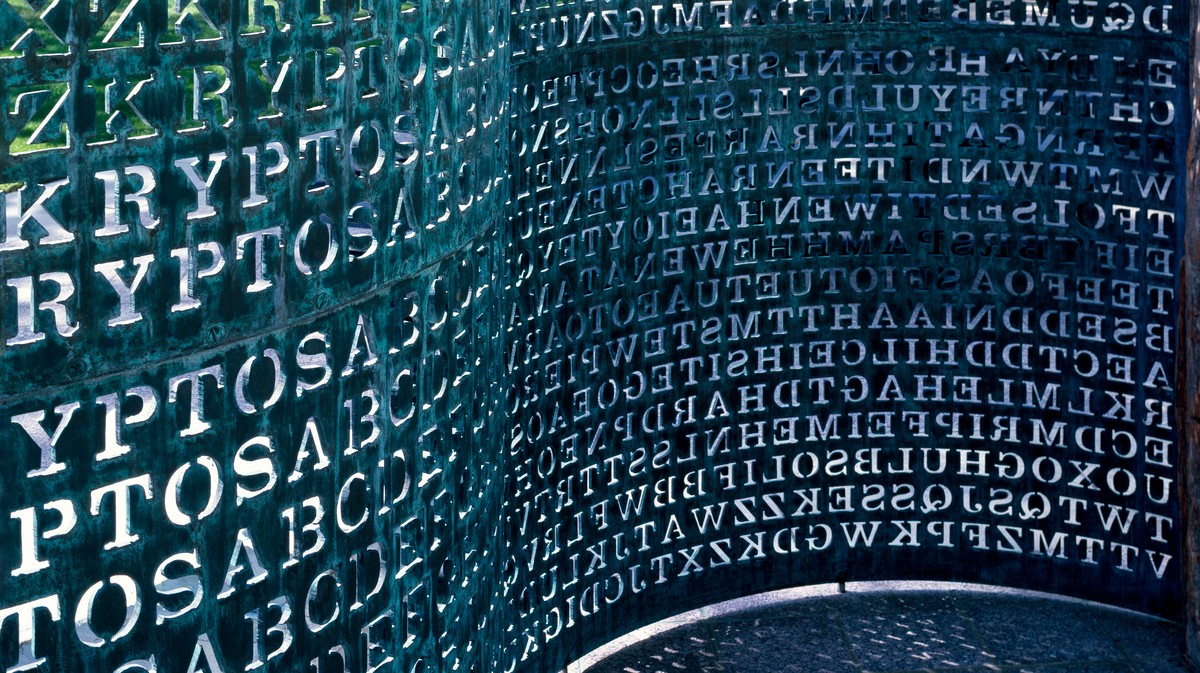The CIA’s Infamous, Unsolved Cryptographic Puzzle Gets A Final Clue

Almost exactly 30 years ago, the artist and sculptor Jim Sanborn was devising an encrypted code for his sculpture complex at the new CIA headquarters.
The centerpiece of the complex, called Kryptos, is an eight-foot tall sculpture of a copper scroll, with four paragraphs of letters cut from the metal. At first glance, the letters seem to be gibberish. But cryptologists, including NSA experts and the American scientist James Gillogly, gradually decrypted the first three paragraphs of the text. But the full solution has eluded cryptographers, and the 74-year-old Sanborn has just released a new clue in order to help hobbyists solve it.
Sanborn’s cryptography has eluded decryption for so long in part because he’s an artist who is interested in cryptography and physics, not a cryptographer by trade. Cryptographers who have tried to decode the sculpture told Motherboard that his code differs from many cryptographic schemes because it has artistic elements that can’t be solved by mathematical decryption methods, which are more common in the space.
In his first projects in the 1970s, he used sculpture to interpret the science of geology, including concepts like the earth’s magnetic field and the coriolis force that acts on rotating objects.
A theme emerged as he saw that his art could expose the invisible elements of science and mathematics, making them visible. When the CIA called for proposals for artwork for its new headquarters, he came up with the idea of exploring how encryption conceals meaning. Decryption, in fact, was perhaps the dream topic for his artistic vision, the perfect example of making the invisible visible.
After his proposal was accepted, the sculpture of Kryptos was gradually born, with its letters cut out of copper in hardcore, labor-intensive, painstaking work. “I went through 900 blades, 7 assistants, 10 jigsaws over a 2.5 year period, cutting it every day 5 days a week,” Sanborn told Motherboard. “I had assistants who had nightmares about it.”
When the sculpture was made, amateur hobbyists took immediate interest in deciphering the encrypted text, which is itself riddlesome. The first out of four paragraphs, for example, has been decrypted to read, “BETWEEN SUBTLE SHADING AND THE ABSENCE OF LIGHT LIES THE NUANCE OF IQLUSION”.
The fourth and final paragraph has, to this day, eluded all efforts at decryption. To the delight of cryptophiles everywhere, Sanborn has just released a new clue to the problem.
“I would prefer the piece to remain a secret indefinitely,” Sanborn said. But at 74 years of age, the artist is getting older, and he wants hobbyists to at least have a shot at solving the puzzle that has vexed them so long.
With his new clue he has decoded a word that shows up early on in the fourth paragraph, now revealed to mean “NORTHEAST.” In 2010 and 2014, he had revealed that two middle words “NYPVTT” and “MZFPK” decrypted to “BERLIN” and “CLOCK,” respectively.
Understandably, the new clue has sparked a new flurry of people working on it. Chris Hanson, a software engineer and self-described nerd, helped cofound a long-standing forum for hobbyists interested in finding the Kryptos solution. Users on the forum such as “Monet Freidrich” have helped decrypt text from the sculpture. But Hanson thinks that the encryption that Sanborn developed for the fourth paragraph may be insurmountable, even with the new clue.
“He probably came up with an encryption technique that he thought would be relatively obvious, but he was thinking like an artist,” Hanson said. “To all the cryptographers that think about this mathematically, and from the rigid formal approach, they are gonna go: ‘you did what!?’”
The paragraphs that Sanborn carved out of copper are examples of classical cryptography, where scientists use two primary methods (also called ciphers) to encrypt strings of text. In the first method, letters from the original text are substituted with other letters. For example, replacing the letter “a” with “o” in the word “apple” encrypts it into the new, gibberish word “opple”.
A second encryption method called transposition consists in the rearrangement of letters. For example, the letters in “apple” might be transposed to form the word “palep”, thereby encrypting the original word.
While the first three Kryptos paragraphs either use only substitution or transposition, Hanson suspects that the fourth paragraph uses both. “It turns out if you use substitution and transposition, one after another in either order, especially on a short message, it makes it really wickedly hard to break,” Hanson said.
Modern cryptographic methods convert strings of symbols into zeros and ones before applying the same fundamental techniques. Commercial and military-grade encryption add to that process the use of advanced mathematical algorithms, making encrypted text infeasible to decode with present-day computers.
But even problems in classical cryptography can prove impossibly hard. There are numerous examples of unsolved classical problems, like Enigma messages from World War II.
Whether or not Kryptos will ever be decoded, Sanborn hopes that the mystery of the sculpture will persist across time, echoing the inscrutable paradoxes of science that mystified him as a student.
“I do think this is the final clue, I’m not gonna give another one,” Sanborn said. “Even once it’s cracked, it’s gonna be a riddle, something that’s still controversial and hard to figure out.”
READ MORE HERE
